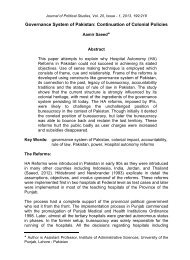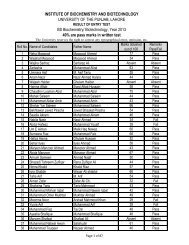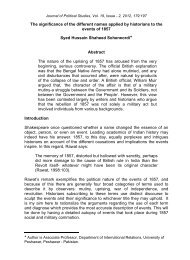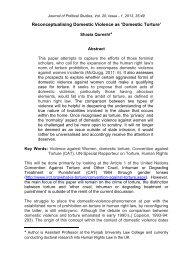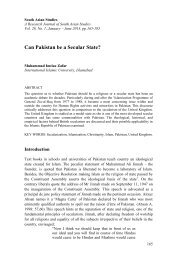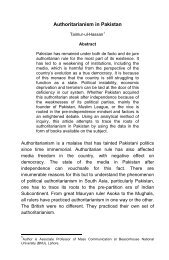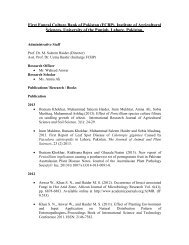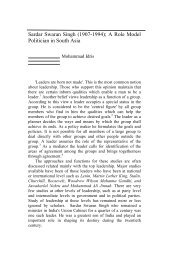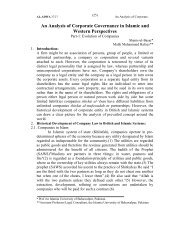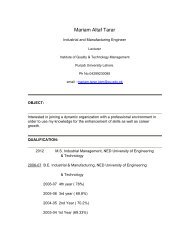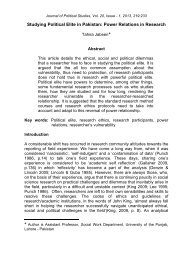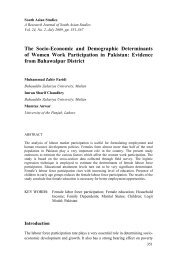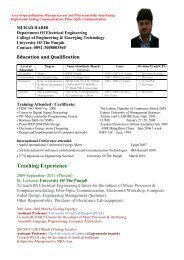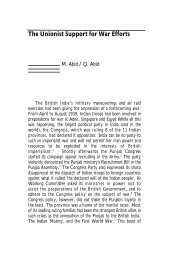pakistan geographical review 1954 - University of the Punjab
pakistan geographical review 1954 - University of the Punjab
pakistan geographical review 1954 - University of the Punjab
You also want an ePaper? Increase the reach of your titles
YUMPU automatically turns print PDFs into web optimized ePapers that Google loves.
It will be seen that <strong>the</strong> distribution <strong>of</strong> principal crops in <strong>the</strong> two wings<br />
<strong>of</strong> Pakistan is <strong>of</strong> a complementary character. Out <strong>of</strong> a total 10,832 thousand<br />
acres under wheat, East Pakistan has only 94,000 acres. Cool early winter<br />
rains and dry and sunny ever summers with plenty <strong>of</strong> water available for<br />
irrigation provide <strong>the</strong> <strong>geographical</strong> background for <strong>the</strong> wheat crop <strong>of</strong> West<br />
Pakistan. It is <strong>the</strong> principal Rabi crop <strong>of</strong> <strong>the</strong> irrigated districts. Similarly<br />
cotton is <strong>the</strong> principal Kharif crop. In <strong>the</strong> irrigated districts <strong>the</strong> bulk <strong>of</strong> it is <strong>the</strong><br />
improved American Cotton. It responds very well to a dry summer and<br />
judicious application <strong>of</strong> water. The physical environment <strong>of</strong> East Pakistan is<br />
too humid and wet for both <strong>the</strong>se crops. Similarly more than 90% <strong>of</strong> maize<br />
is produced in <strong>the</strong> irrigated and well watered districts <strong>of</strong> <strong>Punjab</strong> and N .W.F.P.<br />
Bajra, Jowar and gram do well in dry areas and sandy and comparatively<br />
infertile soils. They are <strong>the</strong>refore grown in <strong>the</strong> unirrigated districts <strong>of</strong><br />
West Pakistan with low rainfall. The" area under Jowar and Bajra in East<br />
Pakistan is practically negligible and that under gram is less than 10%.<br />
East Pakistan his about 90% <strong>of</strong> <strong>the</strong> rice and all <strong>the</strong> acreage under jute.<br />
Jute is a very exhausting crop but <strong>the</strong> application <strong>of</strong> manures is uneconomic<br />
owing to its low price. It can stand floods, and is actually greedy for water<br />
right upto <strong>the</strong> time <strong>of</strong> harvest. Annual renewal <strong>of</strong> fertile silt on a very extensive<br />
scale, maintenance <strong>of</strong> high temperatures and good rainfall, <strong>the</strong>refore, contribute<br />
to <strong>the</strong> heavy concentration <strong>of</strong> this crop in East Bengal which has been producing<br />
about 65 to 80 p.c. <strong>of</strong> <strong>the</strong> worlds' jute. The main jute area is concentrated<br />
along <strong>the</strong> banks <strong>of</strong> <strong>the</strong> three principal rivers, Jamuna, Padma and Meghna on<br />
account <strong>of</strong> <strong>the</strong> availability <strong>of</strong> fresh water for steeping. Cheap and industrious<br />
labour, requiring hours <strong>of</strong> standing in water and unsusceptible to <strong>the</strong> stagnant<br />
smell produced in retting is ano<strong>the</strong>r important factor.<br />
Similarly, large area flooded every year, existence <strong>of</strong> numerous Bhils<br />
and swamps, war.n winters and long summers with high average temperature<br />
and good rainfall extending over both early and late summer, pro vide a suitable<br />
environment in which rice replaces wheat as <strong>the</strong> principal foodgrain here. It is<br />
cultivated all over East Pakistan, excepting <strong>the</strong> saline coastal areas. Three<br />
crops are grown in a year, Arnan (winter rice), Aus (autumn or summer rice)<br />
and Bora (spring rice). This crop is <strong>the</strong> mainstay <strong>of</strong> <strong>the</strong> people. It gives a<br />
higher return per acre for <strong>the</strong> dense population and its straw provides food for<br />
cattle. A small quantity <strong>of</strong> rice is also grown in West Pakistan where it is<br />
mainly distributed in <strong>the</strong> flooded riverain areas or depress e d Barani or irrigated<br />
areas.<br />
12



